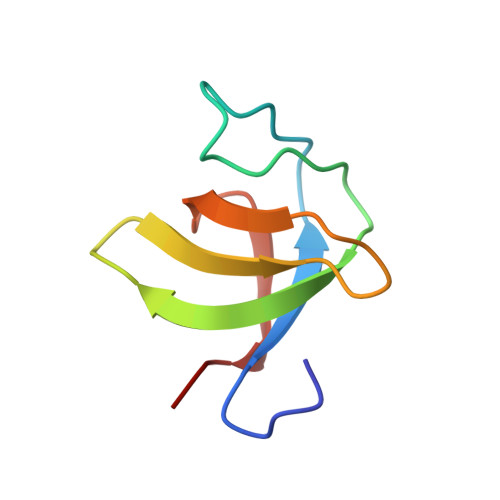Paxillin and ponsin interact in nascent costameres of muscle cells
Gehmlich, K., Pinotsis, N., Hayess, K., van der Ven, P.F., Milting, H., El Banayosy, A., Wilmanns, M., Ehler, E.(2007) J Mol Biol 369: 665-682
- PubMed: 17462669
- DOI: https://doi.org/10.1016/j.jmb.2007.03.050
- Primary Citation of Related Structures:
2O9S, 2O9V - PubMed Abstract:
Muscle differentiation requires the transition from motile myoblasts to sessile myotubes and the assembly of a highly regular contractile apparatus. This striking cytoskeletal remodelling is coordinated with a transformation of focal adhesion-like cell-matrix contacts into costameres. To assess mechanisms underlying this differentiation process, we searched for muscle specific-binding partners of paxillin. We identified an interaction of paxillin with the vinexin adaptor protein family member ponsin in nascent costameres during muscle differentiation, which is mediated by an interaction of the second src homology domain 3 (SH3) domain of ponsin with the proline-rich region of paxillin. To understand the molecular basis of this interaction, we determined the structure of this SH3 domain at 0.83 A resolution, as well as its complex with the paxillin binding peptide at 1.63 A resolution. Upon binding, the paxillin peptide adopts a polyproline-II helix conformation in the complex. Contrary to the charged SH3 binding interface, the peptide contains only non-polar residues and for the first time such an interaction was observed structurally in SH3 domains. Fluorescence titration confirmed the ponsin/paxillin interaction, characterising it further by a weak binding affinity. Transfection experiments revealed further characteristics of ponsin functions in muscle cells: All three SH3 domains in the C terminus of ponsin appeared to synergise in targeting the protein to force-transducing structures. The overexpression of ponsin resulted in altered muscle cell-matrix contact morphology, suggesting its involvement in the establishment of mature costameres. Further evidence for the role of ponsin in the maintenance of mature mechanotransduction sites in cardiomyocytes comes from the observation that ponsin expression was down-regulated in end-stage failing hearts, and that this effect was reverted upon mechanical unloading. These results provide new insights in how low affinity protein-protein interactions may contribute to a fine tuning of cytoskeletal remodelling processes during muscle differentiation and in adult cardiomyocytes.
Organizational Affiliation:
Institute of Biochemistry and Biology, University of Potsdam, Germany. k.gehmlich@ucl.ac.uk

















